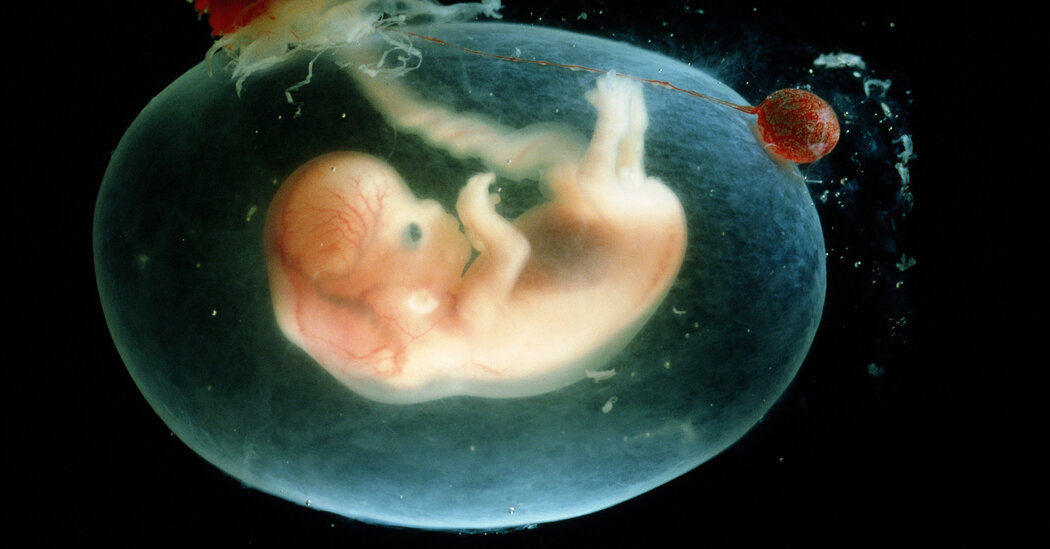
It takes a lot of energy to grow a baby – ask anyone who's been pregnant. But scientists are only now finding out how much.
In a study published Thursday in the journal Science, Australian researchers estimated that a human pregnancy requires nearly 50,000 food calories over the course of nine months. That's the equivalent of about 50 pints of Ben and Jerry's Cherry Garcia ice cream, and much more than the researchers expected.
Previous estimates were lower because scientists generally assumed that most of the energy involved in reproduction ends up stored in the fetus, which is relatively small.
But Dustin Marshall, an evolutionary biologist at Monash University, and his students found that the energy stored in a baby's tissues represents only about 4% of the total energy cost of pregnancy. The remaining 96% is the extra fuel a woman's body requires.
“The child himself becomes a rounding error,” Dr. Marshall said. “It took a while to figure it out.”
This discovery emerged from Dr. Marshall's long-standing research into metabolism. Different species must meet different energy demands. Warm-blooded mammals, for example, can maintain a constant body temperature and remain active even when the temperature drops.
But being warm-blooded also has disadvantages. Maintaining a high metabolic rate requires mammals to constantly stoke the furnace. A cold-blooded snake, in contrast, can go weeks between meals.
Dr. Marshall set out to compile a comprehensive inventory of the energy consumed by dozens of species over their lifetimes. He recognized that most females must not only fuel their own bodies, but must also provide additional energy to their offspring.
When Dr. Marshall began looking into the costs of reproduction, he could find no solid figures. Some researchers had hypothesized that indirect costs – the energy women use to fuel their bodies during pregnancy – might amount to only 20% of the energy directed into the baby's tissues. But Dr. Marshall didn't trust their hypotheses.
He and his students decided to estimate the costs themselves. They analyzed the scientific literature for information such as the energy stored in each child's tissues. They also looked for the females' overall metabolic rate during reproduction, which scientists can estimate by measuring the amount of oxygen consumed by the mothers.
“People were just collecting data on their own species, but no one was putting it together,” Dr Marshall said.
By aggregating that data, the researchers estimated the costs of reproduction for 81 species, from insects to snakes to goats.
They found that an animal's size has a big influence on how much energy it needs to reproduce. Microscopic animals called rotifers, for example, require less than a millionth of calories to produce offspring. In contrast, a white-tailed deer needs more than 112,000 calories to produce a fawn.
A species' metabolism also plays a role. Warm-blooded mammals use three times the energy of reptiles and other cold-blooded animals of the same size.
The biggest surprise came when Dr. Marshall and his students discovered that in many species the indirect costs of pregnancy were greater than the direct costs.
The most extreme results came from mammals. On average, only 10% of the energy used by a female mammal during pregnancy is allocated to her offspring.
“It shocked me,” Dr. Marshall said. “We went back to the sources many times because they seemed surprisingly high based on the expectations of the theory.”
David Reznick, an evolutionary biologist at the University of California, Riverside, who was not involved in the study, was also surprised by how high the indirect cost might be. “I wouldn't have guessed it,” he said.
Yet what surprised him even more was that Dr. Marshall's team was the first to establish these numbers. “It's disarming,” he said. “You think someone has done this before.”
The study offers clues as to why some species have higher indirect costs than others. Snakes that lay eggs use much less indirect energy than snakes that give birth to live young. Live snakes must support embryos as they grow in their bodies, while egg-laying mothers can release offspring from their bodies more quickly.
There may be several reasons why mammals pay such high indirect costs for pregnancy. Many species, for example, build a placenta to transfer nutrients to their embryos. Dr. Marshall suspects that humans pay a particularly high cost because women stay pregnant longer than most other mammals.
Dr Marshall said the new findings could also explain why female mammals put so much effort into caring for their young after birth: why they put in so much effort during pregnancy.
“They already have large sunk costs in the project,” Dr. Marshall said.
